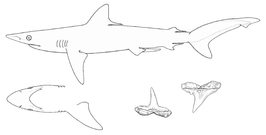Hardsnuithaai
| Hardsnuithaai IUCN-status: Gevoelig[1] (2020) | |||||||||||||||||
|---|---|---|---|---|---|---|---|---|---|---|---|---|---|---|---|---|---|

| |||||||||||||||||
| Taxonomische indeling | |||||||||||||||||
| |||||||||||||||||
| Soort | |||||||||||||||||
| Carcharhinus macloti (Müller & Henle, 1839)[2] | |||||||||||||||||

| |||||||||||||||||
| Verspreiding | |||||||||||||||||
| Afbeeldingen op | |||||||||||||||||
| Hardsnuithaai op | |||||||||||||||||
| |||||||||||||||||
De hardsnuithaai[3] (Carcharhinus macloti) is een haai uit de familie van de requiemhaaien.[4][5]
Natuurlijke omgeving
De hardsnuithaai komt voor in de Indische Oceaan en het westen van de Grote Oceaan. Meer in detail van west naar oost bij Kenia,[5] Tanzania,[5] Pakistan,[5] India,[6] Sri Lanka,[5] Andamanzee,[5] Myanmar,[5] Vietnam,[7] China,[5] Taiwan,[5] Hongkong,[8] Nieuw-Guinea[5] en de Arafurazee.[9]
Synoniemen
- Carcharias macloti - Müller & Henle, 1839[2]
- Hypoprion macloti - (Müller & Henle, 1839)[2]